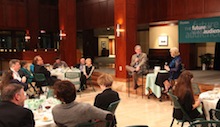
- Paul Taylor, executive vice president of special projects at the Pew Research Center, talks about demographic trends impacting the news industry, at a Poynter discussion moderated by Jill Geisler, Poynter senior faculty, leadership and management.
Journalism executives and other participants at Poynter’s Future of News Audiences conference heard Sunday night what some would have preferred not to hear: younger generations simply aren’t growing into dedicated consumers of news the way their parents and grandparents did.
As young adults age and begin families, the theory goes, they start to care more about the world around them and read the news — a development that would help reverse the fortunes of news organizations which have seen precipitous declines in their audience numbers. But this may be a false hope — so far there is no “life cycle” effect, at least none that can be detected.
Paul Taylor, Pew Research Center executive vice president of special projects, said researchers in 2012 asked consumers how many minutes they devoted to taking in the news the day before. While the Silent Generation spent 84 minutes with the news, Boomers devoted 77 minutes and Gen Xers reported 66 minutes, Millennials said they spent just 46 minutes consuming news — a figure that hasn’t changed appreciably since 2004.
Decreasing news consumption among younger consumers is a challenge for news executives, more than two dozen of whom are meeting at Poynter through Monday to discuss how audiences are changing — and journalism with it.
The country is in the throes of a dramatic demographic transition, Taylor said: the United States will soon be a majority of minorities, and its population is growing ever older. And for the first time in U.S. history, young adults in their 20s and 30s are worse off than their parents, with less wealth and higher rates of poverty and unemployment. Further, when the young grow old, the traditional safety net provided by Social Security and Medicare won’t be as strong as it was for their parents and grandparents.
“The math doesn’t work anymore,” Taylor said. “You end up with a generation aging in with its own economic difficulties.”
For news organizations, the dilemma is how to engage this younger audience. Taylor said the Millennial generation is interested in the world, but doesn’t feel a strong need to tap traditional news sources. Instead, younger consumers are more likely to “bump” into the news as they go about their way on social media.
They also are somewhat narcissistic, Taylor said, and more wary than their elders of institutions — religious, political, economic, and perhaps media as well.
Yet Taylor said he remains optimistic about the future of news.
“I don’t think it is inevitable that people will lose an appetite for news,” he said, noting the human need to know what is going on. At the end of the day, he said, people do want a clearer understanding of the developments around them and better ways to navigate information than they have now.
If nothing else, Taylor said, he wanted to leave the message that there are stories to be told in these shifting trends, many of which Taylor and his colleagues at Pew have captured in a new book, “The Next America: Boomers, Millennials, and the Looming Generational Showdown” scheduled for release in March.
The Future of News Audiences conference, supported by the MacArthur Foundation and the Council for Research Excellence, continues Monday. Among the discussions will be one focused on audiences for news and information that serve democracy, led by Vivian Schiller, Twitter’s head of news.
Related: Pew surveys of audience habits suggest perilous future for news | Pew: TV is ‘the dominant way that Americans get news at home’







Comments